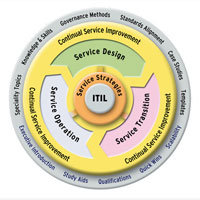|
|
|
 |
| |
| ITIL & ITSM |
| |
| What is ITIL? |
 The IT Infrastructure Library® (ITIL) is the most widely accepted approach to IT service management around the globe. The IT Infrastructure Library® (ITIL) is the most widely accepted approach to IT service management around the globe.
ITIL is a best practice framework that has been drawn from both the public and private sectors internationally. It describes how IT resources should be organized to deliver business value, documenting the processes, functions and roles of IT Service Management (ITSM).
ITIL was originally developed at the same time as, and in alignment with BS 15000, the former UK standard for IT Service Management. In 2005, BS15000 was fast-tracked to become ISO/IEC 20000, the first international standard in IT Service Management.
ITIL is owned and maintained by the UK Office of Government Commerce is committed to the maintenance of alignment between future versions of ITIL and ISO/IEC 20000.
The IT Infrastructure Library (ITIL) is the de facto industry standard for driving Information Technology transformation. ITIL recognizes that IT is not just another cost center, a black hole that can only be tamed through draconian cost reduction programs. The ITIL v3 framework shows how to strategically align your IT services with business objectives and convert IT into the cost reduction and revenue generating engine powering the entire enterprise.
|
| |
| Why Implement ITIL in Your Organization? |
 Many executives express frustration even as they attempt to reign in the chaos and expense associated with their IT investments but find little in the way of substantive guidance. The IT Infrastructure Library (ITIL) is the most universally accepted approach to the management and delivery of IT Services. Many executives express frustration even as they attempt to reign in the chaos and expense associated with their IT investments but find little in the way of substantive guidance. The IT Infrastructure Library (ITIL) is the most universally accepted approach to the management and delivery of IT Services.
Many IT departments behave reactively, responding to events as they occur - for example, a server crash. Because unscheduled work tasks take priority over planned work, staff find that they are always behind. By implementing ITIL, an organization can overcome this cycle and get clear insight into the Total Cost of Ownership (TCO) and activities in the IT department. |
| |
| Organizational Benefits to ITIL |
Successful introduction of IT Service Management with ITIL should deliver the following benefits:
• Improved customer satisfaction through a more professional approach to service delivery
• Improved IT services through the use of proven best practice processes
• Improved delivery of third party services through the specification of ITIL
• Improved morale of service delivery and recipient staff
• Increased competence, capability and productivity of IT staff
• Improved systems/ applications availability
• A clear business differentiator from competitors
• Closely aligned to commercial business services and products
• Reduced hidden costs that traditionally increases substantially the TCO
• A benchmark to measure performance against in IT projects or services
• Reduced cost of recruitment and training - hiring ITIL qualified people is easier
• Reduced cost/ incident
• Better asset utilization
• Improved ROI on IT
• Increased staff retention
• Reduced cost of training
• greater visibility of IT costs
• greater visibility of IT assets
The economic impact of ITIL implementation will be realized in all of the areas above. The benefits can also be viewed in terms of direct and indirect savings. Costs relating to missed opportunities and not being able to operate will be reduced significantly.
|
| |
| Who Else Has Implemented ITIL? |
| Many large international organizations have implemented ITIL such as Microsoft, IBM, Atos, Caterpillar, Shell Oil, Boeing and many more and have all reported great success and significant operational cost savings as a direct result of ITIL adoption. |
| |
| What We Do? |
| TechFeat Consulting focuses on the Value Chain engine of Information Technology across three levels. Level 1 consulting is directed at getting IT's own house in order. Our consulting expertise runs deep through IT Service Management (ITSM), Asset Life Cycle Management (ALM) and Roles Based Security Management (RBSM) solutions that not only improve operations, compliance and TCO but repair IT's image and credibility with internal customers. Best practice people, process and technology transformation success can then be applied to the business as a whole supporting external customers. Level 2 and 3 consulting attacks the 80 - 20 monster, which has companies still spending over 80% of their IT dollars providing basic support and maintenance and what's leftover on innovation. The ITIL v3 framework can be applied to strategic value streams, shifting savings achieved through Level 1 operational improvements to build and fund external customer support technologies and the service portfolio that generates revenue. |
| Please contact us for a consultation to get started on your ITIL needs. |
|
|
|
|
| |
